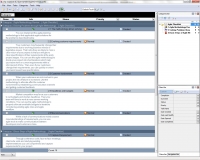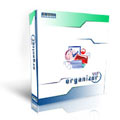|
Task Management Software |
 |
|
|
|
|
| |
|
 TESTIMONIALS TESTIMONIALS
|
|
"...This is an excellent program. I'm so glad that I stumbled on to this when researching for task management programs. Very low learning curv, quite flexible, and the price is right. Tried at least 20 other programs, either too complicated, too expensive, or poor documentation..."
Chad Lindsey -
Honolulu, HI
|
|
|
|
|
|
|
|
Agile Checklist |
|
|
|
|
|
|

 |
The following Agile Checklist gives you a quick review of the agile methodology, its advantages and limitations and allows you to understand the basic steps of this PM methodology.
|
| Order 750 checklists in MS Word and PDF printable format at $49.99 USD only. |
BUY NOW!  |
- Methodology Review.
- Definition. Agile methodology is a powerful project management approach introduced by Dr. Winston Royce. It provides many opportunities to organize projects throughout the development process and allow project teams to efficiently respond to the unpredictability of software building activities through running sprints, which are incremental and iterative work cadences. The methodology covers a set of software development approaches and systems, including Extreme Programming, Modeling, Scrum, Crystal methodologies, Feature-Driven Development, and Adaptive Software Development.
- Advantages. This methodology gives you and stakeholders of your project four basic advantages (also knows as "XP values") which are listed below:
- High communications between your developers and your customer.
- Simplicity of design.
- Continuous modification of project requirements according to your customer’s feedback.
- Encouraging your customer and developers in improving project processes by the developing and maintaining the feedback cycle.
- Limitations. Agile development in IT projects is targeted at establishing quick development of working code that fits specific requirements of the customer. Although it seems this methodology is quite efficient, there are several limitations that make it inapplicable to other types of projects. The limitations are listed below.
- Green-field engineering and maintenance. These methodologies are not applicable to green-field engineering and maintenance because systems do not assume creating and using large flows of documents.
- User involvement assumes involving the user in the software development process so the success of your project will greatly depend on the collaboration and communication with the user.
- Orientation on specific problems. Methodology principles allow a group of developers to concentrate on development processes, and the quality level of their effort will considerably depend on their skills and behaviors, not on the systems and techniques they use to apply their knowledge. Then this methodology will be best for solving specific problems while general problems may be left without required treatment.
- Small team. It be best for relatively small-sized teams, so such methodologies will not work well for groups with a large number of members.
- Why Use Agile Methodology. Consider the following reasons when deciding on using the methodology:
- The methodology provides you with multiple ways to define and measure the direction of your project throughout the development lifecycle, giving you more tools to control and assess the project.
- You can break the development lifecycle down into regular cadences of work (sprints or iterations), and then your team will receive a measurable increment of work at the end.
- Your team can continually revisit every aspect of software development (like requirements, design, testing, etc.) throughout the entire lifecycle.
- You can efficiently track iterations every two weeks and quickly re-orient your project team toward the right direction.
- Solving Problems.
- The methodology allows solving four basic problems of most software development projects. You can implement the methodology to find applicable solutions for the problems described below.
- Evolving customer requirements. Your customers may frequently change their requirements due to evolving business needs or legislative issues. That’s why they are likely to miss a clear vision of your project so that you will get no clear specifications of their requirements at the early project stages. You can divide your project into short iterations which help your team work on current requirements within a short period of time. Then even if your customers change their requirements, you can quickly re-orient your team toward new specifications.
- Customer involvement. When your customers are not involved in your project, the risk of failure is increased. Use the methodology to allocate effort for customer involvement by establishing communication channels and getting customer feedback.
- Deadlines and budgets. Market competition may force your customers to cut budgets and shorten deadlines. Then your team will have to work at more severe working conditions. You can properly allocate available budgets to iterations considering existing agile roles and workflow.
- Miscommunications. While a lack of communications mainly causes misunderstandings of requirements, you can use tools to make communication between developers and customers close.
- Basic Steps.
- Capture Requirement. Through conference calls, face-to-face meetings, client side visits and studying existing implementations you can comprehend and capture requirements for your project.
- Prototype. By following the captured requirements you can develop a product prototype and use high-level diagrams to show your customer what your project will deliver.
- Project Modules. Break your project down into multiple modules or iterations (each of the modules finishes with some result to be demonstrated to your customer). Therefore, your customer is able to track project progress and notify you if any change is required.
- Periodic Review. Your project should be regularly reviewed by the project leader. At the end of each week you need to provide your customer with an update of the project schedule showing completed targets and planned targets for the next week.
- Use Checklists. Use the checklist method to plan and deploy your project. Such a method allows your team to follow a suite of checklists, dramatically reducing common mistakes made while coding, releasing and deploying.
- Implement Bug Tracking System. With help of project management software (e.g. VIP Task Manager) you can manage tasks related to debugging. Such software will let quality engineers working on your project to manage project improvements and use advanced tools for tracking, reporting and auditing of features in your project product.
- Implement Version Control System. Such a system allows you to reduce the risk of failure due to errors and unmet requirements in code lines by implementing agile metrics for controlling current version of your project product.
| Order 750 checklists in MS Word and PDF printable format at $49.99 USD only. |
BUY NOW!  |
|





 |
CentriQS Tasks Management Solution 
Looking for multi-user task management software? Try CentriQS complete task management solution for planning, tracking and reporting tasks, projects, and schedules. Increase productivity of your small business or office by better organizing your employees' tasks and time.
 FREE Download CentriQS FREE Download CentriQS
|
|
|
|
|
|
|
|
|
|
CentriQS  -15% OFF -15% OFF |
All-in-one business management software
for small and midsize enterprises |
 |
|
|
| VIP Task Manager |
Multi-user project management software
to plan, schedule and track project tasks. |
 |
|
|
| VIP Checklists
|
More than 750 ready-to-use to-do lists
to plan your personal and business life |
 |
|
|
| VIP Team To Do List |
Professional task management software
to make and send team todo lists by email |
 |
|
|
| VIP Organizer |
Personal time management software
to organize time at home and at work |
 |
|
|
| VIP Simple To Do List
|
Simple and effective to-do list software
to plan daily chores, trips, wedding, etc. |
 |
|
|
|
|
|
|
|